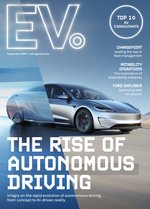The Genesis of Autonomous Driving: From Concept to Reality

The journey of autonomous driving began in the mid-20th century, rooted in theoretical ideas and pioneering experiments. In the 1950s, General Motors introduced the Firebird II, a visionary concept car that teased the possibility of automated driving through guide wires embedded in roads. Fast forward to the 1980s, when the pace of innovation quickened with the DARPA-funded Autonomous Land Vehicle (ALV) project, which marked the first successful attempt at autonomous navigation using computer vision and sensors.
The 1990s: Laying the foundation
The 1990s were pivotal in transforming autonomous driving from theory to practical application. Carnegie Mellon University's Navlab and the European Commission's PROMETHEUS Project demonstrated the potential of autonomous technology. These initiatives laid the groundwork for what was to come in the new millennium.
The 2000s: A new era of competition and innovation
The dawn of the 2000s brought a significant milestone with the DARPA Grand Challenge, a competition that spurred teams to develop fully autonomous vehicles capable of navigating challenging off-road courses. The event signalled a considerable leap forward, demonstrating the feasibility of autonomous driving and setting the stage for rapid advancements.
The 2010s: Tech giants enter the fray
As the 2010s unfolded, the race toward autonomy accelerated, with tech giants and traditional automakers diving into the field. Rapid advancements in sensors, machine learning and real-world testing brought autonomous driving closer to reality. Hiroshi Lockheimer, SVP of Platforms & Ecosystems at Google, captured the moment: "Autonomous vehicles have the potential to transform mobility by making transportation safer and more accessible."
Today: Imagry at the forefront of autonomous innovation
Today, the once-distant dream of autonomous driving is becoming a reality, with technology and legislation paving the way. At the forefront of the revolution is Imagry, a company that has developed AI-based, HD-mapless Level 3 and Level 4 self-driving systems designed for both passenger vehicles and buses. The innovative approach has caught the attention of global players, including Continental, the world's third-largest Tier-1 supplier, which has integrated Imagry's technology into its autonomous driving platform for cars.
Imagry's cutting-edge technology draws inspiration from the complexities of biological systems. Its software combines real-time vision-based perception with imitation-learning AI, creating a highly efficient and scalable driving decision-making network. By using low-cost sensors and eliminating the need for constant satellite connections or expensive digital HD-maps, Imagry has developed a location-independent technology that enables the quick deployment of autonomous vehicles on unfamiliar roads.
Eran Ofir, Imagry's CEO, is a seasoned executive with a global perspective. With experience across four continents, he has successfully led business units at major tech companies, driving growth and achieving significant commercial milestones. Eran reflects on the journey toward autonomy, stating, "The main story of autonomous vehicles is that it is finally happening. We've been talking about autonomous driving for a decade, creating many new businesses and waves of hype, to no avail. Now, it is finally happening as we reach the tipping point where things are materialising."
Autonomous cars vs. buses: The path to adoption
As countries begin implementing legislation for Level 3 autonomous driving—conditional automation—Eran emphasises that Level 4, involving high automation, will likely gain traction first in public transportation. "It will be buses and public transportation that will happen first," he predicts, pointing to the complexities of implementing such technology in passenger cars versus controlled environments like bus routes.
Dependencies for autonomous vehicles: Computing power and legislation
The future of autonomous vehicles hinges on two critical dependencies: high-performance computing and supportive legislation.
The brain behind autonomy
High-performance computing is essential for processing the vast amounts of data autonomous vehicles require. Eran explains, "In computing, our vehicles today use about 5 to 15 Tera Operations Per Second (TOPS). However, autonomous vehicles' starting block is 150 TOPS and upwards." The dramatic increase in computing power is necessary to handle the complex tasks that autonomous driving demands.
Paving the way for autonomy
Legislation is the second crucial factor, as governments worldwide actively pass laws and conduct trials for autonomous public transport. Eran notes Japan's aggressive goals, with plans to have 50 autonomous bus locations by 2025 and 100 by 2027. While these targets are ambitious, they underscore the global momentum toward autonomy.
The debate: HD-maps vs. HD-mapless systems
Maps play a critical role in autonomous driving, but the industry is divided between two approaches: HD-maps and HD-mapless systems.
HD Maps: The detailed approach
HD maps offer a detailed, centimetre-level representation of the environment, capturing everything from lane markings to subtle road textures. "The HD-maps allow autonomous vehicles to anticipate road features and navigate with precision, even in complex environments," Eran explains. However, they require constant updates to reflect real-world changes, which can be a limitation if the environment doesn't match the pre-mapped data.
HD-Mapless: Real-time flexibility
In contrast, HD-mapless navigation relies on real-time data from sensors like LiDAR, cameras and radar to interpret surroundings and make driving decisions on the fly. The approach offers flexibility and adaptability, especially in unfamiliar or rapidly changing environments. Eran adds, “however, it demands more from the vehicle's onboard processing power and sensor accuracy.”
The choice between HD maps and HD-mapless systems often depends on the use case. HD maps are ideal for stable, well-known routes, while mapless systems excel in dynamic or unpredictable settings where real-time decision-making is crucial. "Both approaches represent different philosophies in the journey toward fully autonomous driving," Eran concludes.
Securing public trust: The imperative of safety
No matter how advanced the technology, public trust is vital for the success of autonomous driving. With 1.35 million people killed in vehicle crashes worldwide each year and 36,096 road deaths in the US alone in 2019, the stakes are high. Given that 94% of crashes are due to human error, the promise of autonomous vehicles lies in their potential to make roads safer.
Safety is the non-negotiable priority. Autonomous driving technology must be proven to be a safer alternative for both drivers and passengers. As Amnon Shashua, CEO of Mobileye, asserts, "The human level of safety is the goal. Anything beyond that becomes a business decision. But getting to the human level, that's our mission."
The future of autonomous driving: A tipping point
As Imagry continues to innovate and take charge, the future of autonomous driving is no longer a distant dream but a rapidly approaching reality. The industry and legislators are overcoming the challenges of creating genuinely self-driving vehicles and the industry stands on the brink of a transformation that will redefine mobility for generations to come.
To read the full story in the magazine click HERE
**************
Make sure you check out the latest edition of EV Magazine and also sign up to our global conference series - Sustainability LIVE 2024
**************
EV Magazine is a BizClik brand


